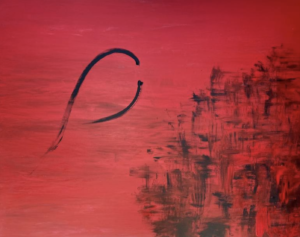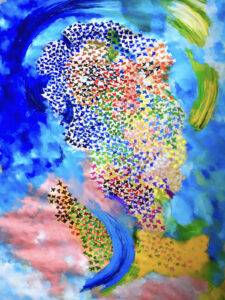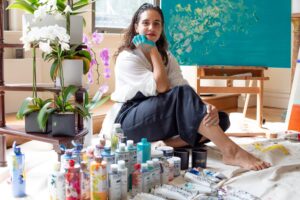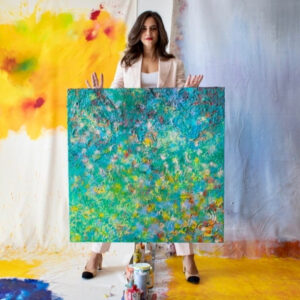Earlier this month, MEPC had the pleasure of interviewing Aida Murad, a self-made Impact Artist whose path towards art is nothing short of impactful. We had the opportunity to listen to Aida’s inspirational story of overcoming adversity through a passion for healing through art.
At 20 years old, Aida was diagnosed with Rheumatoid Arthritis. As a result, she was semi-paralyzed for 4.5 years. Although she endured irreparable damage to both of her hands, Aida began to look towards art creation in this time of darkness. She forwent paintbrushes and commenced painting solely with her hands. Today, Aida combines her experience as an Artist and Art Coach to create transformational art journeys and fine art by painting with her fingers. Through her artwork, Aida seeks to enhance people’s physical spaces and simultaneously bring healing.
As of April 2023, Aida has sold out 10 collections and has been featured in 31 exhibitions. Her artwork has been featured globally including in TED, TEDinArabic, Voice of America, Reuters, TRT World, Al Jazeera, World Bank and the United Nations. She was also named the 2022 Georgetown University Artist in Residence where she created healing art for the Lombardi Comprehensive Cancer Center. She has collaborated with Grammy Award-winning artists including the drummer from The Doors, John Densmore, to use art for social good.
Her paintings have been acquired globally including by the previous Chairman of Saatchi & Saatchi and Manchester United, previous Deputy Minister of Culture of the U.A.E, Qatar America Institute for Culture, Board Member of the National Museum of Mexican Art and the previous Chairman of the U.S. Commission on Civil Rights under Obama’s administration at a historical landmark in Chicago. She has previously organized a mental health summit at the height of COVID with Deepak Chopra’s foundation and has been a founding organizer for the first festival in the US celebrating refugee talents in the creative industries that gathered over 4,000 individuals at the Washington National Cathedral.
Born and raised in Jordan, Aida did not know she would end up in the art world. She attributes her Arab community as influential in the beginning of her professional career.
“[Jordan] is very family-oriented and society oriented, meaning the way you formulate your hopes and dreams is really based on what the society has formed as successful or as appropriate or not appropriate. So in my upbringing, I actually started working at a very early age, 13 years old. I loved, and still love, business and building things,” Aida said.
Aida observed the traditionally successful career paths such as an engineer, doctor, scientist. However, she didn’t feel a pull towards any of them. Later, she came across economics.
“I thought economics is what really governs the world. I wanted to be smart and successful, so I picked that path. That was deemed, society-wise, smart and successful,” Aida said.
Aida moved to the U.S. to attend George Washington University as a double major in economics and international development. As an undergraduate student, she wanted to work for a cause larger than herself.
Aida recounts: “I wanted to be much older than my age too quickly and too soon. I worked 40 hours a week at an international development firm. I also studied 40 hours a week as I wanted to be an A+ student and I wanted to fit into every social circle.”
Aida says she “overnight became semi-paralyzed from severe arthritis” because of her high-stress life, induced partially by the high pressure she imposed on herself.
She says: “I remember in my senior year and part of my junior year of university, I kept saying I wanted a break. The interesting part is I put this all on myself. No one told me I needed to work all this time, no one told me to not sleep well, etcetera, etcetera, etcetera. And then, I got my break, I became semi-paralyzed for four and a half years.”
Following her diagnosis, she moved back to Jordan to recover. She applied her study of economics through jobs in the Jordanian government. Two incidents within one day changed her world:
- Doctors told Aida she will most likely never be able to use her hands as they are deteriorating and will have permanent deformity
- One interview question when applying to an economic-affiliated job
“The interviewer asked me why should we hire you, what’s unique about you. At the time, I didn’t have the language to understand what depression was and I just said I have no idea. I genuinely didn’t have a clue as to why I was unique. I didn’t get the job, so I walked back home, wondering: why am I here, what is unique about me?” Aida said.
Aida turned to the facts, and remembered she had a unique fingerprint. She bought paint to start painting with her hands—fingerprint specifically. Despite being confronted with the reality of her “deteriorating hands,” she saw fingerprinting as a mode of freedom and distinctiveness.
It was during this painting session that she unlocked what she found was unique about herself.
Interestingly enough, Aida remembered as a kid, she would stare at the paintings in her grandfather’s home, her aunt’s home, her home, for hours. Art has been her calling from the very beginning.
Previously, societal conceptions of a “successful career” and financial uncertainty deterred her from acknowledging art as her passion. But her adversity showed her the path to a career in art.
Aida explained that she did not have a single example of a successful female artist who was Arab.
As an artist, Aida believes that harmful stereotypes about artists, specifically, the “starving artist” trope need to be rethunk.
“When you think of artists, almost immediately, you think of starving artists like, ‘oh, they have no money.’ And only the 0.01% make it and then they die, and then they sell for millions of dollars. That’s just one point that we have to shift from,” Aida said.
“When we shift, we have to know what we’re shifting into. So I replaced starving artists to thriving artists. I don’t need to make hundreds of millions of dollars, although that’d be lovely. But you can be thriving the same amount as an engineer at Google,” Aida continued.
Aida follows through with her goal of also shedding light on more female Arab successful artists and art collectors. Arabs are the lowest among her art collectors as they make up less than three percent. She hopes to highlight misconceptions about needing to be of a certain social class to be able to start collecting art.
She became her own example of a successful female Arab artist.
“I started using art as a tool for my own healing journey. Part of my approach was to never just put paintings in an exhibit. It had to have storytelling with it,” Aida said. “That started getting a following from people saying ‘wow those words, that story behind that painting really left me with a lesson, it really moved me’…Fast forwarding nine years, I’m doing it now full time.”
Throughout the nine years into transitioning into art, she has faced many obstacles.
“I remember when I started being an artist…a friend introduced to me this art dealer, just to have a conversation, and she looked at my art and she said ‘I’ll maybe put it in the bathroom of a hotel’…The way she said it was really rude and condescending. Sometimes I remember her every so often and I’m like, I don’t need you to like me. I don’t need you to see my art—I see my art,” Aida said.
Central to her art journey has been to accept there will be instances where people express their disinterest in her art; it was a form of vulnerability for Aida to accept that not everyone will love what she loves.
Aida’s artistic vision for her artworks has a process. She does not give herself a deadline of how many pieces she has to complete, allowing her process-oriented mindset to shift her relationship with society’s vision of productivity. Rejecting contemporary ideas of productivity, she instead incites the element of surrender and expansion.
Aida explains, “each painting has about six to seven layers of paint so when I’m creating it, I am not trying to get it to a certain outcome. I don’t know when it’ll be done. That takes off the pressure of productivity.”
“I just know when a painting is done. It’s quite a beautiful way to create, and some paintings I will leave for a year and not touch while some paintings I’ll finish quickly,” Aida continued. “Actually I have one painting that I did in 45 minutes, which is the shortest amount of time and what’s interesting is it had the biggest exposure.”

Her 45-minute painting was a response to bombings in Gaza.
“I asked my male friend what can I do. I felt like I couldn’t do anything…What is a single person going to do? He said I refuse that answer,” Aida said.
“So I just went to my studio and sat on the floor, feeling sorry for myself. I then remembered, I can paint. Maybe I can do something with art. I just had a knowing I’ll do something and that’s when I created that painting,” Aida continued.
The painting is titled Dreams of Peace in Gaza. It was published in the journal of the University of Cambridge with Ai Weiwei who wrote the preface.
Her most memorable artwork, though, is titled Mind of Magic.
Describing her inspiration and contextual background for Mind of Magic, Aida explained: “It was at the start of Covid. I was isolated from people; I didn’t have a hug for three months. What I did to help me not feel depressed was paint what I wished the world would look like, how the world would feel like.”
Every day Aida would paint what she wished she “would feel in the world;” she wishes for the happiest world without isolation. Once she finished, she found a surprise waiting for her.
“Fast forward to when it was done: I had no idea when I flipped it over, it was a profile of a person. I realized it was the mind of magic. It reminds me that there is so much magic to be held in our minds, in our hearts, and in our life,” Aida said.

As the interview comes to an end, Aida dives into the upcoming project that she is most excited about. It is based on her favorite question: what if it could be better than you imagined it to be?
“I dream of creating spaces that you can come in and be prompted and guided on how you can foster your imagination muscle. Part of that is you creating different art, you being around art that helps foster that. And then with my coaching experience, I want to incorporate the prompts. I truly believe every person has the solutions they need for their life,” Aida said.
“The question is, do we have space and time to sit in and find that? Not everyone does. Not everyone has the luxury,” Aida continues. “I dream of programs that I’ll create where the people are sponsored. They’re paid to come and sit and imagine: what if their life could be better than they imagined it to be? And it’s amazing to see the things that they move from, ‘I imagine having a consistent meal every day’ and then it goes to ‘wow, I imagine owning the restaurant.’ Or something they couldn’t even have thought of. That’s a project I’m really excited for, building the dreaming muscle for the world.”
As of late, Aida recently finished a large art installation for TEDinArabic in Qatar and is preparing for her opening of an art exhibit in Los Angeles, Washington D.C. and New York.
You can find more information regarding Aida here: https://www.aidamurad.com/
Support Aida’s art: https://www.aidamurad.com/shopart
Support Aida’s Art Journeys: https://www.aidamurad.com/art-journeys
Stay up to date with Aida’s projects on her social media platforms:
Instagram: https://www.instagram.com/muradaida/
LinkedIn: https://www.linkedin.com/in/aida-murad/



